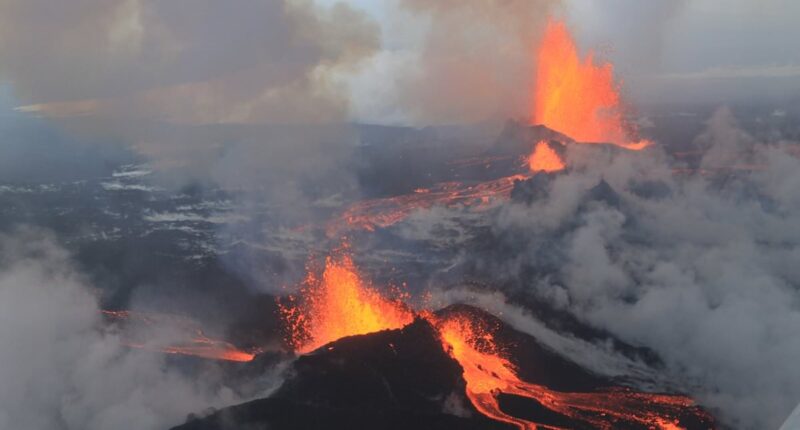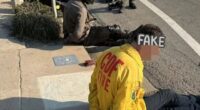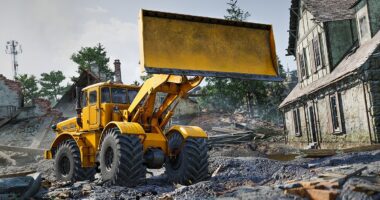One of Iceland’s largest volcanoes is on the brink of erupting, experts have warned.
Bárðarbunga – the second-largest volcano in the country – has been hit with a swarm of 130 earthquakes within just five hours.
This is a key sign an eruption could be imminent, according to The Icelandic Meteorological Office (IMO).
For safety measures, the aviation color-code for Bárðarbunga has been increased from green to yellow, signaling ‘elevated activity above normal background levels’.
Aviation color-codes offer pilots and aviation regulators details concerning the possible existence of volcanic ash in the air, which might disrupt flights.
Situated beneath Iceland’s biggest ice cap (Vatnajökull) in the heart of the country, Bárðarbunga had its previous eruption a decade ago, leading to a red travel warning.
The volcano’s previous eruption in 2014/15 emitted large volumes of sulphur dioxide and impacted air quality.
However, there was little effect on flights outside of the immediate vicinity as it didn’t produce as much volcanic ash.

The 2014-2015 Holuhraun eruption was the largest outbreak in Iceland for over 300 years and lasted for almost six months. Pictured, September 4, 2014
‘Bárðarbunga is unique in that it is an unusually large volcanic system, partly covered by a glacier,’ said the IMO in a statement.
‘The observed seismicity is consistent with increased pressure caused by magma accumulation, which has been ongoing since the last eruption in 2015.’
Fears started on Tuesday when a ‘strong’ earthquake swarm began shortly after 6am UTC in the northwestern part of the Bárðarbunga caldera, according to IMO.
Earthquake activity was most intense until around 9am UTC, after which it began to decrease, although earthquakes are still being recorded in the area, it said.
The largest quake at 8:05 UTC registered at magnitude 5.1, capable of ‘minor damage’, while 17 earthquakes measured magnitude 3 or higher.
Earthquake activity has been increasing gradually in Bárðarbunga over recent months and four earthquakes measuring magnitude 5 or higher were detected in 2024, the department added.
In the past four years, the Icelandic volcanoes of Fagradalsfjall and Sundhnúkur have hit the headlines for consistent eruptions, although these are further southwest, closer to capital city Reykjavík.
Many of these eruptions were preceded by earthquakes with magnitudes somewhere between five and six.

This map from the Icelandic Meteorological Office’s earthquake monitoring system shows the locations of the earthquakes, with the black circle indicating the Bárðarbunga caldera outline. Bárðarbunga is located under Iceland’s most extensive glacier (Vatnajökull) in the centre of the country. It is 2,300 feet deep with a total area of 25 square miles

This bar chart indicates the hourly earthquake count. Earthquake activity was most intense until around 9:00 UTC, after which it began to decrease, though earthquakes are still being recorded in the area. It is too early to determine whether the swarm is subsiding

Bárðarbunga is located under Iceland’s largest ice cap (Vatnajökull) in the centre of the country. Bárðarbunga’s ice-filled crater or ‘caldera’ is 6.2 miles wide

On August 29, 2014, a fissure eruption started in Holuhraun at the northern end of a magma intrusion that had moved progressively north, from the Bardarbunga volcano. Bardarbunga is a stratovolcano located under Vatnajokull, Iceland’s most extensive glacier
However, unlike recent eruptions in the Reykjanes Peninsula, Bárðarbunga is located in a more remote area, within Iceland’s largest ice cap, meaning people and infrastructure are less at risk.
Earthquakes can trigger volcanic eruptions through severe movement of tectonic plates – the jigsaw-style sections of Earth’s crust and uppermost mantle.
Valentin Troll, professor of petrology and geochemistry at Uppsala University in Sweden, thinks the swarms could potentially lead to an eruption.
‘The unrest at Bárðarbunga is in addition to long term inflation of the system over the last few years and could herald developments towards a new eruption,’ he told MailOnline.
‘However, earthquake swarms like the recent one are not necessarily leading to an eruption, and it is thus too early to be certain.
‘If an eruption occurs, it would possibly look like a repeat of the 2024/15 eruption, which was spectacular to watch but posed no serious danger to populations or livestock and infrastructure due its relative remoteness.
‘Alternatively, we may face an eruption inside the caldera (under the ice), which could lead to unpleasant phreatomagmatic eruptions where magma/lava and glacial melt water interact to cause steam explosions.’
Large earthquakes – greater than magnitude 6 – can trigger an eruption or to some type of unrest at a nearby volcano, according to the United States Geological Survey (USGS).

Iceland is a particular hotspot for seismic activity because it sits on a tectonic plate boundary called the Mid Atlantic Ridge

Lava pictured flowing across one of the roads near Grindavik on November 21, 2024 with the Blue Lagoon geothermal spa to the right

Pictured, Iceland’s popular Blue Lagoon geothermal spa, a popular tourist attraction, which has repeatedly been closed and reopnened in the last few years
Volcanoes can only be triggered into eruption by nearby tectonic earthquakes if they are already poised to erupt – when there’s enough ‘eruptible’ magma within the volcanic system and significant pressure within the magma storage region.
‘If those conditions exist, it’s possible that large tectonic earthquakes might cause dissolved gases to come out of the magma (like a shaken soda bottle), increasing the pressure and possibly leading to an eruption,’ USGS says.
In the past four years, Iceland has seen a series of eruptions at the Reykjanes Peninsula, a volcanic hotspot southwest of capital Reykjavik.
After remaining dormant for 800 years, the Reykjanes Peninsula suddenly became active again in 2021 at the Fagradalsfjall volcano.
In late 2023 and early 2024 new volcanic fissures formed near the fishing town of Grindavik, pumping huge plumes of lava out onto the surface.
The resulting eruptions led to the evacuation of the town, destroyed houses and repeatedly closed the Blue Lagoon – one of the country’s most popular tourist destinations.
In November 2024, the geothermal spa closed when its car park was engulfed in lava, although the Blue Lagoon website says ‘specialized protective barriers’ are ‘safeguarding Blue Lagoon’s vital infrastructure against potential lava flows’.
For many locals, the events have revived the trauma of the disastrous explosion at another of Iceland’s volcanoes, Eyjafjallajokull, back in 2010.
While the eruption didn’t kill anyone, it did produce a huge cloud of ash that prompted the biggest global aviation shutdown since World War II.



















